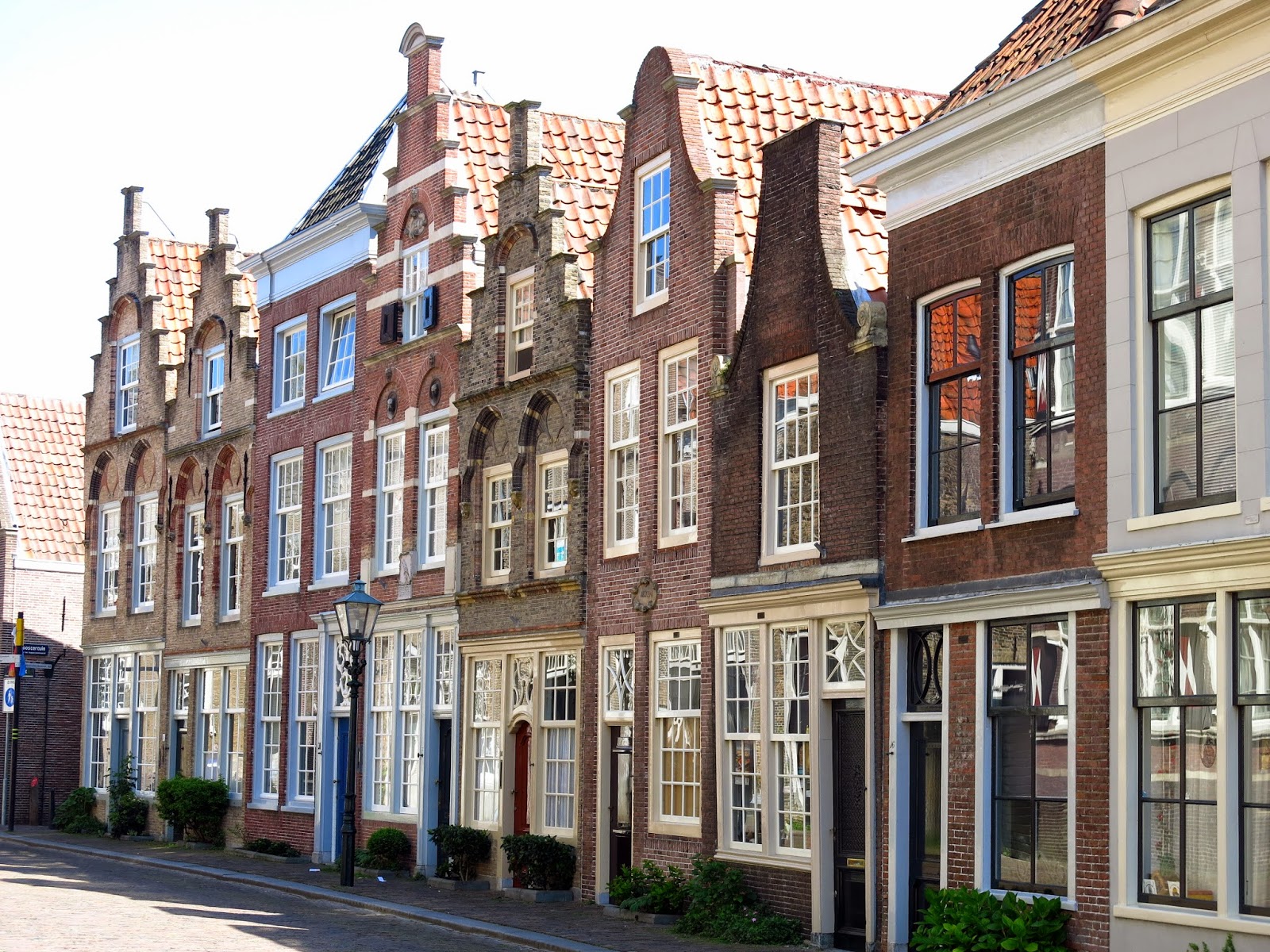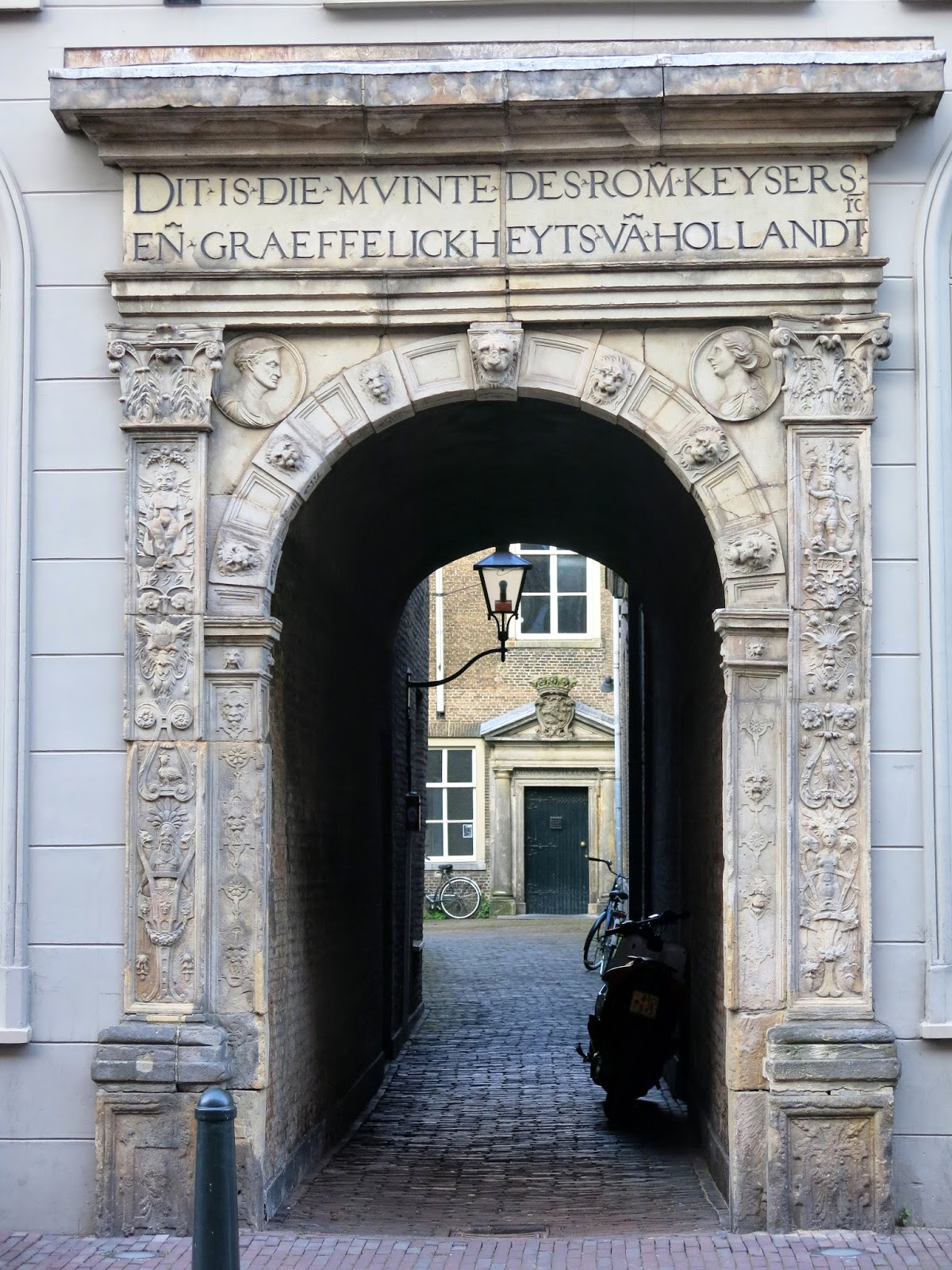A day out in Dordrecht, the oldest city in Holland. Walled,
moated and gated at one time, now only two gates are left, and there is water, even
in abundance.
Why Dordrecht? Too many reasons to list:
- not to let my free
train travel ticket expire
- To see an exhibition,
- to attend an
organ recital.
- last but not least,
although there might not be enough time to do it all, to see the choir stalls
in the old church, a church painted and photographed by so many through the centuries.
Old houses near the Museum
Since we celebrate the fact that
the Netherlands became a kingdom 200 years ago, there are events and exhibitions
everywhere, mainly about the first three kings: William I, II, and III. The
exhibition in Dordrecht was about William II, who married Anna Paulowna, a sister
of Tsar Nicholas I of Russia, and a lover of art, as was William. He collected
paintings and objects of art. His paintings and parts of his art collection
were exhibited in the Museum of Dordrecht, a former monastery. Many pieces of
art came from St Petersburg where they ended up after Wlliam’s death. He left
huge debts, and so his collection was sold to museum in various countries.
Celebrating 200 years
The back of the Augustinian church...
...and the houses opposite
Another part of the exhibition presents
the visitors with a history of William and Anna’s life together, the palaces
they built, their lavish life style, and especially Williams history, connected
with the Battle of Waterloo in which William fought as well. After that battle in
which he was wounded, he was hailed as the hero of Waterloo, at least in the
Netherlands.
The organ recital was in a historic
church as well, the Augustijner
Kerk (Augustinian church). The programme presented us with “royal” music:
music played at courts throughout Europe, courts which were connected with the
Dutch court, and music of famous musicians who played at court in The Hague.
Seeing friends, starting the day
having coffee with them, spending time together in the Museum and meeting again
at the organ recital was good.
Organ and interior of the Augustinian Church
Dordrecht was quite an experience. As
mentioned before it has been painted by many artists because of its dominant
position on the busiest European intersection of several main rivers and
waterways. The main church with its stump tower is a very impressive landmark.
Paintings and later photos are always taken from across the wide expanse of the
rivers. It is as if the church rises out of the water, sitting on its surface.
Dordrecht used to be a very important staple town, and the names of the
numerous old warehouses remind us of that time of prosperity: Russia, German
princedoms, English place names.
Some gable stones
The historic harbour with old steamers, still
in working order but no longer used for freight, the many canals, and beautiful
gables of the houses of the VIPs, the ship owners, patricians and other wealthy
and influential people, are worth seeing and testimony of a rich past.
The historic harbour. Below, a very grand warehouse
There is however a “but”. Although Dordrecht
was mainly spared during the war and not bombed as so many other cities, unlike
Rotterdam its heart was still intact. A heart consisting of small and
characteristic houses, alleys and tiny squares. But that heart was nonetheless
ripped out wilfully in the name of progress and replaced by an intersection of
several wide pedestrian streets lined with shops behind modern facades, the kind
of shops which can be found anywhere in the Netherlands. The streets are very
clean and very neat but have no character whatsoever. It could be anywhere.
During the day the streets were bustling with people, and a big street market
was in full swing which lent it some character with its varied display of fresh
fruits and vegetables, all kinds of fish, cheeses, and cured meats. But in the
evening after closing time the streets were empty and deserted, except for the
cleaners in their vehicles, cleansing the smooth pavement of any nasty smells
of rotting fruit and fish, disinfecting them more or less. No heart, no people
enjoying drinks in small establishments.
Looking into and out of the city through one of the gates
The "main" gate, the entrance from the river crossing
Around this emptiness, this neat
black hole, there are still many old streets, squares, gateways under houses
leading to a canal, steps down towards the water, house fronts leaning over,
beautifully decorated gables and sky lights over the front doors. Even the
modest old houses look nice. Apparently they were built with love and care.
Walking towards the main gate giving access to the river and wide vistas, big
ships coming, going and crossing, I see most interesting houses, gable stones,
inscriptions. Dordrecht had many religious houses, and also for protestants it
is of historic importance.
The main church and the canal
We had time to visit the main church. On
one side it is flanked by a canal, the houses opposite built with their feet in
the water, occasional staircases giving access to cellars or the streets on the
other side of the houses. Beech trees line the canal and the green around the
church, the young and just unfolding leaves a very bright and translucent green
and coppery red, sunlight shining through them. Inside the church is light and
spacious, the choir almost as long as the nave of the church. To me the big
pipe organ and the choir stalls are the most interesting parts of this church.
The choir screen made of brass
Two exanples of misericords
The frieze in the choir stalls
The beautifully decorated choir stalls
The stall ends
The pulpit
The main pipe organ
Especially the choir stalls are unusual. They have misericords which seem
rather medieval like so many others elsewhere, and are also badly defaced,
which isn’t unusual either although a great shame. But all along the choir stalls
is a very beautiful frieze, sculpted in wood. It is a wide one over the seats with representations of what seem to be
Roman or Greek battles. They are beautifully made and well preserved. They are
in a neo classical style, which forms a contrast with the stalls and their
misericords. I have only 45 minutes to look around the church, so there is no
time for a closer examination. There is a splendid book about the choir stalls
and its sculptures, and in the nick of time I buy it when the kiosk is already
closed. But the ladies who are on duty are still around and only too happy to
sell me this book.
With my treasure, which I
accidentally leave in a restaurant so that I have to walk all the way back from
the station to the other side of Dordrecht to retrieve it, we set out to
explore the old part of Dordrecht, the harbour, canals, city gates and old
houses, ending up at the uttermost point where we can enjoy a drink and some
food while basking in the sun and watching the many huge cargo ships pass by.
And here we end our day, very happy and content, till we discover I have
forgotten my book!
Along a quiet canal, and another view of the church
I should go back one day, to explore Dordrecht in more
detail.
It was a memorable day, and although I did not get my
money’s worth out of my free ticket as Dordrecht is only an hour away on the train, it was certainly
worth it.
Some impressive houses and front doors
One of many gateways








































I've never been to Dordrecht, but it looks like it's worth a visit!
ReplyDelete